Mills in Alto Aragón - harinero
Loporzano
Loporzano is a village in the
Hoya de Huesca region. Loporzano is easily reached from Huesca city taking the
main road (N-240) for Barbastro. After a while You'll find a branch for Loporzano (A-1227). Once there, do not enter
the village but drive straight on till you reach the bus shelter. Turn left to the municipal swimming pool and find a parking spot.
From there you can walk the path to the viewpoint (mirador) and the old washing place (antiguo lavadero).
Do not miss the branch (after about 800 m) where the lavadero path goes to the left.
You'll reach the lavadero after about 1.3 km. Continue and follow the track down into the valley of the Río Flumen.
After about 1 km more you'll reach the mill (1).
Pictures: 03.iii.2019

(1) The mill site with the power station left, and the flour mill back center.
The site is a compound of four buildings surrounding a central square.
The two largest are the constructions that interest us. On the left (1) we see the electrical power plant. The building at the back and center contains the grain mill and the miller's residence (6, 7).
The mill is built next to the Río Flumen but had not the necessary rights to impound the water. So there is no mill pond and the miller was completely dependent on the river. The Flumen has a very irregular flow with occasional flash floods, but it is also one of the most rich watercourses in the region.

(2) Diario de Huesca, 11.iii.1896

(3) Diario de Huesca, 30.viii.1918
Over the years we have seen the mill pop up several times in the newspapers (2, 3) with a message that the mill now works day and night
. It is interesting to learn that there was also a pig boar living at the mill (2) and that it must have been well enough
known to mention its transfer to a farm.
So, even if there was no storage, water appears to have been available in quantities sufficient to work day and night.
The dam, el azud de Tierz, is situated about 1.3 km against the current from the mill and it is the start
of the irrigation canal of Tierz, further to the South.

(4) End of the canal; the wall behind is the upper floor of the flour mill.
Notice the reflection of the water in the irrigation canal of Tierz in the bottom right corner.
The canal (4, 5) is wide and deep. The end of the canal is covered with a concrete roof
and has two exits: straight ahead goes to the power station and the gate on the left is for the grain mill.
The canal ends level with the second floor of the mill, where the living quarters (6) were.
A door in the back wall makes it easy to get from the living room to the canal. Inside, stairs lead down to the place where the millstones rest (7).
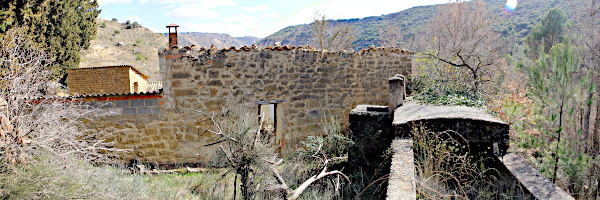
(5) Upper floor with its entrance and chimney of the fire place visible in 6.
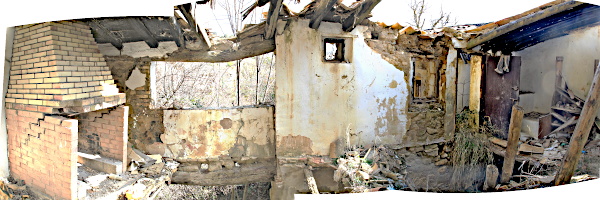
(6) Upper floor: view from the entrance visible in 5.
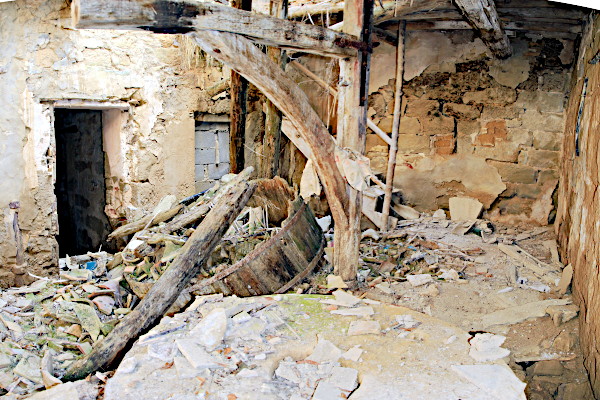
(7) Working place at ground level: one stone pair with crane.
The workshop on the ground floor (7, 8) is one big mess with rubbish and chunks from the roof and the top floor.
It appears originally two pair of stones may haven been present. Nowadays, at the place where the second pair may have been, wooden steps are leading
to the upper floor (at the back in 7).
Apart from the remaining pair of stones (&empty 130cm) and the crane (7 center), no tools or other equipment could be found.
The door left in picture 7 leads down to the underhouse, but the stairs were in such a bad state that I didn't dare descend them.
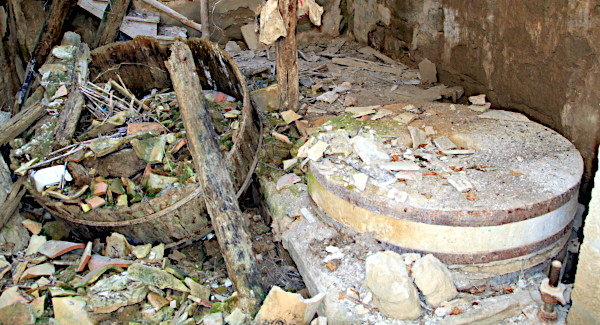
(8) Stone case with one pair of stones ∅ 140 cm
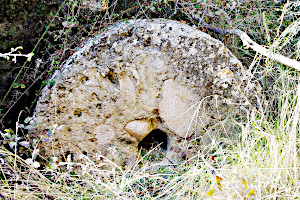
(9) Old stone ∅ 130 cm
Outside a decommissioned stone (9) can be found. It is a pudding stone with a diameter
of 130 cm, slightly smaller than the more modern stone inside.










